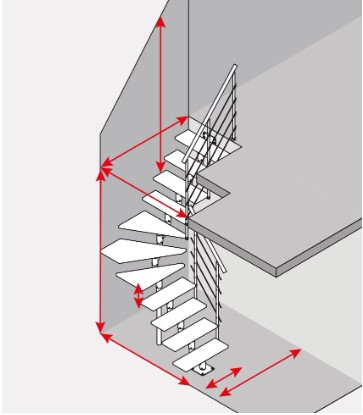Accurately measuring for a staircase is crucial to ensure its safety, functionality, and compliance with building regulations. Whether you’re planning a new staircase or renovating an existing one, having precise measurements will help you select the right design, materials, and installation method.
This comprehensive guide will walk you through the step-by-step process of measuring for a staircase in the UK, providing essential tips and considerations along the way.
Tools You Will Need
To measure your staircase accurately, you’ll need a few essential tools:
- Tape Measure: A long, durable tape measure (at least 5 meters).
- Spirit Level: To ensure horizontal measurements are level.
- Pencil and Paper: For jotting down measurements.
- Calculator: For any necessary calculations.
- Straight Edge or Ruler: For marking points accurately.
Having these tools ready will make the measurement process smoother and more precise.
Step-by-Step Guide
1. Rise and Run
The rise and run are the fundamental components of any staircase.
- Rise: This is the vertical height from one step to the next. To measure the rise, place your tape measure vertically between two steps from the top surface of one tread to the top surface of the next. Repeat this for each step to ensure uniformity. The maximum rise per step in the UK is 220mm.
- Run (Going): The run is the horizontal distance from the front edge of one step to the front edge of the next step. Measure from the front edge (nosing) of the tread to the front edge of the next tread. Ensure that each tread is at least 220mm deep, as per UK regulations.

Image source: www.sogem.eu
2. Total Rise
The total rise is the vertical height from the floor at the bottom of the staircase to the floor at the top. To measure this:
- Start from the finished floor level at the base of the staircase.
- Measure straight up to the finished floor level at the top.
- Ensure your tape measure is straight and taut for an accurate reading.

Image source: builderbill-diy-help
3. Stair Width
The width of your staircase affects its comfort and safety. While there is no minimum width for domestic staircases, most UK stairs are between 860mm and 900mm wide. To measure the width:
- Measure from one side of the staircase to the other, across the widest part.
- Repeat this measurement at several points along the staircase to check for any variations.
4. Landing Depth and Width
Landings are the flat areas at the top or bottom of the staircase, or where the staircase changes direction. To measure a landing:
- Depth: Measure from the front edge of the top tread to the back wall or obstruction.
- Width: Measure from one side of the landing to the other.
Ensure that the landing is deep and wide enough for safe use, especially if it will accommodate a turn or winder steps.

Image source: www.sogem.eu
5. Headroom
Headroom is the clear vertical space above any step or landing. UK regulations require a minimum headroom of 2 meters. To measure:
- Measure from the edge of the step or landing vertically upwards to any overhead obstruction (such as a ceiling or beam).
- Make sure this measurement is consistent along the entire length of the staircase.
6. Handrail Height
Handrails should be between 900mm and 1000mm from the pitch line (the line along the staircase that follows the slope of the treads). To measure:
- Measure vertically from the nose of the tread (front edge) to the point where the handrail will be placed.
- Ensure this measurement is consistent throughout the staircase.
Additional Considerations
- Building Regulations: Familiarize yourself with the specific building regulations in your area regarding staircase dimensions, materials, and safety standards.
- Staircase Design: Consider the desired style, materials, and functionality of the staircase. Consult with a professional if needed to help you choose the best design for your space.
- Professional Assistance: If you’re unsure about any of the measurements or staircase design, it’s advisable to seek professional assistance from an architect or builder.
Common Measurement Mistakes
- Inaccurate measurements: Double-check all measurements to ensure accuracy.
- Neglecting landings: If your staircase has landings, make sure to measure their dimensions correctly.
- Ignoring headroom: Ensure there is sufficient headroom to avoid injuries.
- Overlooking building regulations: Familiarize yourself with local regulations to avoid compliance issues.
Staircase Design Tips
- Consider the space: Choose a staircase design that is appropriate for the available space and the overall style of your home.
- Prioritize safety: Ensure the staircase is safe and easy to navigate, especially for children and the elderly.
- Optimize natural light: If possible, design the staircase to maximize natural light.
- Add personal touches: Incorporate decorative elements, such as lighting fixtures or artwork, to personalize your staircase.
Staircase Materials and Costs
- Common materials: Explore different materials for your staircase, such as wood, metal, or glass.
- Cost considerations: Consider the cost of materials, labor, and installation when making your decision.
- Maintenance requirements: Evaluate the maintenance requirements of different materials to determine the best option for your lifestyle.
Conclusion
Measuring for a staircase requires careful attention to detail and adherence to UK building regulations. By following the steps in this guide, you’ll be equipped to take accurate measurements and plan your staircase project with confidence.
Remember to take your time, double-check your measurements, and consult a professional if needed.
Frequently Asked Questions (FAQs)
To calculate stairs in the UK, measure the total rise (vertical height from the lower floor to the upper floor) and divide it by the ideal riser height (usually around 190-220mm) to determine the number of steps. Then, calculate the run (horizontal depth) of each step to ensure it meets UK regulations, which require a minimum going of 220mm per step.
To measure for a staircase, you need to:
1. Measure the total rise (from the floor at the bottom to the floor at the top).
2. Measure the width of the staircase.
3. Measure the run (depth of each step) and the rise (height of each step).
4. Check headroom clearance (minimum 2 meters).
5. Determine handrail height (between 900mm and 1000mm from the pitch line).
In the UK, the recommended width for a domestic staircase is typically between 860mm and 900mm to ensure comfort and safety. However, there is no strict minimum width requirement in building regulations, though wider staircases are generally more convenient.
To measure the rise and run for stairs:
1. Rise: Measure the vertical distance from the top of one step to the top of the next step.
2. Run (Going): Measure the horizontal distance from the front edge of one step (nosing) to the front edge of the next step. Ensure each step has a rise of no more than 220mm and a going of at least 220mm to comply with UK regulations.
